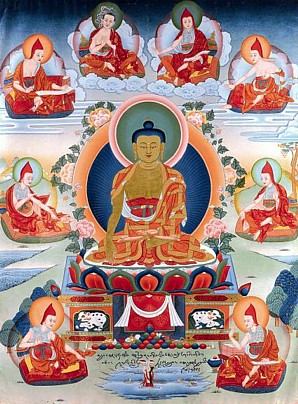Shastra: Difference between revisions
Jump to navigation
Jump to search
mNo edit summary |
mNo edit summary |
||
| Line 40: | Line 40: | ||
==External links== | ==External links== | ||
* | *{{LH|tibetan-masters/sakya-masters/khenpo-shenga/notes-from-miscellaneous-writings|Notes from the Miscellaneous Writings of Khenpo Shenga}} | ||
[[Category:Key Terms]] | [[Category:Key Terms]] | ||
[[Category:Texts]] | [[Category:Texts]] | ||
Revision as of 20:53, 29 October 2011

Shastra (Skt. śāstra; Tib. བསྟན་བཅོས་, tenchö; Wyl. bstan bcos) — a treatise or commentary upon the words of the Buddha (Tib. བཀའ་, ka; Wyl. bka’). In Tibet, many of the most important shastras composed by the great Indian masters of the past were compiled into a collection known as the Tengyur, or translated treatises, comprising around 228 volumes (depending on the edition).
Commentary
The Sūtra Requested by Devaputra says:
- All Dharma teachings are included within the Buddha’s word and the treatises,
- The excellent speech and the commentaries on its intended meaning,
- By means of these, the teaching of the Shakya
- Will remain for long within this world.
As this says, all the excellent teachings of the Dharma can be included within two categories: the speech of the victorious Buddha and the treatises which provide commentaries on its intended meaning.
Vasubandhu said:
- That which subdues all the enemies, one’s own afflictions,
- And guards against future existence in the lower realms,
- Is called a ‘treatise’, because it subdues and protects,
- These two features are not found in other traditions.
- --Well Explained Reasoning
Patrul Rinpoche says:
- There are four obstacles which can prevent those with understanding from taking interest in a particular treatise. They are:
- thinking that it is devoid of any purpose,
- thinking that it has a purpose but that one would never be able to accomplish it,
- thinking that although possible it is not something an honourable person would wish to pursue, or
- thinking that even though it is honourable, there are other easier methods or that there is a lack of connection (between the methods and the goal).
- In the present case, if we take each of these in turn, then:
- unlike a treatise on dentistry for crows, for example, generally there is some purpose to it.
- Furthermore that purpose is achievable, so it is not like a treatise on stealing the crown jewel from the naga king.
- Not only that, but the aim, which is achievable, is also a sublime aim for individuals to pursue, so it is not like a treatise on how to marry your mother.
- Then, it is not that the methods for accomplishing this supreme objective bear no relation to what is in the treatise, as in the case of [a text about] sacrificing animals in order to gain rebirth in the higher realms.
- --From An Overview of The Ornament of Clear Realization, the Treatise of Essential Instructions on Transcendental Wisdom